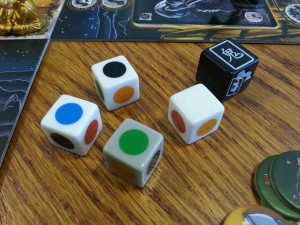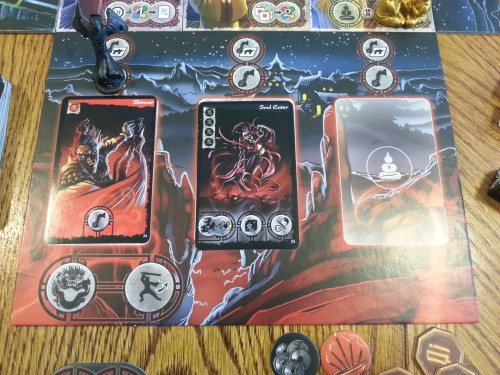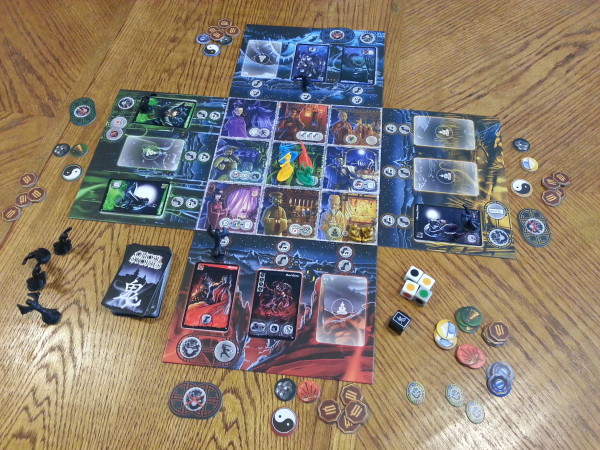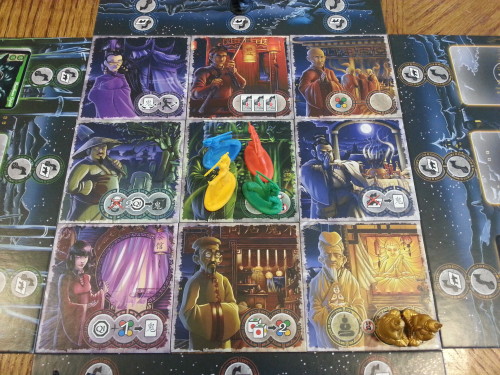Ghost Stories
Let me start by saying that this is the first “grown up” table-top / board game I ever played, and that it opened my eyes to the fact that board games don’t have to be bored games. Thanks, Steve, for bringing this over on your visits and introducing us to it!
Ghost Stories is a great co-op survival game from Antoine Bauza that is difficult on the easiest rule-set and fun to play even when you lose… which you will do, often.
In Ghost Stories, the players take on the role of a group of Taoist monks that happen upon a village that is coming under assault from ghosts and other baddies. These ghosts are being led by Wu-Feng, a particularly powerful spirit, in one or more of his assorted incarnations. Each of the four Taoists (red, green, yellow and blue) has two powers that are unique to them, but you play with only one active. Taoists are distributed randomly to each player, and the power your Taoist can use is also determined randomly. During the game, as your Taoist takes damage by various means, you lose Qi tokens. If you lose all your Qi tokens your Taoist is dead, although resurrection is possible using one of the village tiles.
The village is comprised of nine tiles arranged randomly in a 3×3 grid. Each village tile represents a villager that can help you in varying ways. Outside the village, along each of the four sides, is a Taoist board with 3 positions available for Ghosts. As ghosts are played, they occupy these village outskirts and assault the village from all sides.
At the beginning of each player’s turn, they draw the top card from the Ghost deck and play it according to its color. A ghost must be played on the player board of the Taoist who shares its color, unless that player’s board is full. A black colored ghost must be played on the drawing player’s board, unless that player’s board is full. If the appropriate board is full, the player may choose which open ghost position to fill with the drawn ghost. Some ghosts are easy to exorcise, while others can take careful planning to defeat.

Ghosts have a color coded power level, such as 1 blue, 3 yellow, or 4 black. The players have a set of 6 sided dice that have one each of a red, yellow, blue, green, black, and white side, where white is ‘wild’. Players can also collect colored Tao tokens of the same colors represented on the dice, except white. To exorcise a ghost, players roll the dice and augment the results by spending their collected Tao tokens to try to equal the power level of the ghost. A ghost with a ‘3 blue’ power level is exorcised if the player is able to amass a value of 3 by combining dice that rolled blue, dice that rolled white, and blue Tao tokens.
Ghosts also have a variety of secondary effects. There are Haunters, which manifest physically and attempt, over the course of a couple of turns, to ‘haunt’ the first un-haunted village tile in front of it. If a village tile is haunted, you flip it over and no longer have access to its ability. A Haunter does not disappear when it haunts a tile, it just resets to the beginning of its track and proceeds to attempt to haunt the next un-haunted tile in front of it. Other ghosts cause you to roll a curse die with a variety of negative effects each time the player on whose board it resides takes his turn, or when the ghost is exorcised. Some ghosts cause you to draw an additional ghost when drawn, and these can chain together if you got an unlucky shuffle. Some ghosts even boast multiple of these effects.

After drawing a ghost, your Taoist can move if he wishes, and then take an action, in that order. There are some circumstances that allow you to take multiple actions, and the village tiles are important to the game, so a fair amount of strategy is required to move and act in the most efficient manner. Economy of action is easily the most important skill used in Ghost Stories, as things can quickly spiral out of control. Even when you think the game is going well, things can go bad over the course of a couple of player turns.
As I said at the beginning of the article, this game is difficult and there are many lose conditions and only one win condition. To win, you must defeat each incarnation of Wu-Feng in the ghost deck. When playing with the easiest rule set, there is only one Wu-Feng incarnation in the deck, and it is the 11th card from the bottom of the deck. In higher difficulty levels, the number of incarnations scattered throughout the deck is increased. If Wu-Feng is not dead by the time the final ghost in the ghost deck gets played, you lose the game. If at any time no Taoists are left alive, the ghosts overtake the village and you lose the game. If at any time three village tiles are haunted at the same time, you lose the game. In my many losses, the vast majority of them have been due to three village tiles being haunted concurrently, preceded about 5 minutes beforehand by someone saying “No, we only have one tile haunted, we can take care of that in a minute after I exorcise this ghost!”
The flavor of this game is fun, and it’s exciting to play even when you lose. The one victory I have had was due to a player who suggested we take turns spending our last life point to instantly kill a ghost, at the expense of our own lives, in the hopes that the next Taoist would not die before his turn began and would then get to spend his last life point suiciding to kill another ghost. It sounded crazy at first, but this tactic followed by some timely resurrections is literally the only reason we were able to eke by at the end and exorcise Wu-Feng.
I have never attempted this game on any difficulty higher than the easiest one, but I eagerly look forward to finding some stalwart companions to die beside me soon. There are also two expansions I have not yet played with, White Moon and Black Secret.
There are rules I have not covered in this review, and they can be a little difficult to understand, as the game has a lot of depth to it, but it’s worth learning. Playing is very fun and I’m always happy to get this game to the table. I would give it 9 out of 10 stars, if only because the rules can be slightly muddy at times and I hesitate to give anything a perfect rating, but Ghost Stories comes very close!


[…] By Bevan Dawson […]